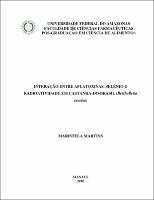| ???jsp.display-item.social.title??? |


|
Please use this identifier to cite or link to this item:
https://tede.ufam.edu.br/handle/tede/3716| ???metadata.dc.type???: | Dissertação |
| Title: | Interação entre aflatoxinas, selênio e radioatividade em Castanha-do-Brasil (bertholletia excelsa) |
| ???metadata.dc.creator???: | Martins, Maristela  |
| ???metadata.dc.contributor.advisor1???: | Pacheco, Ariane Mendonça |
| ???metadata.dc.description.resumo???: | A segurança alimentar é um importante aspecto a ser alcançado pela indústria de alimentos e a contaminação de alguns produtos, como a castanha-do-Brasil (Bertholletia excelsa H. B. K.), causada por aflatoxinas e radioatividade tem sido evidenciada em diversos estudos. Composto natural da castanha-do-Brasil, o selênio constitui um elemento apreciado pela ação antioxidante, presente em grandes quantidades em alguns alimentos, como, por exemplo, em nozes de árvores. Entretanto, é um elemento bastante estudado devido à ambigüidade de sua ação, benéfica ou tóxica em organismos. Considerando estes aspectos, amostras de castanha-do-Brasil classificadas em diferentes tamanhos, sem casca, tipo exportação foram avaliadas com o objetivo de estudar a interação dos níveis de radioatividade, selênio e a contaminação por aflatoxinas. A análise de selênio foi realizada por espectrometria de emissão óptica com plasma indutivamente acoplado (ICP/OES), utilizando o método de emissão atômica. O limite de detecção (LOD) foi de 1,50 μg/g, e o limite de quantificação (LOQ) foi de 3,00 μg/g. As análises de aflatoxinas foram realizadas por espectrometria de massa/massa (MS/MS) acoplado a um cromatógrafo líquido (LC) com Ionização Química à Pressão Atmosférica (APCI). Os limites de detecção (LD) e de Quantificação (LQ) para ΣAFLs foram: 0,3 e 0,85 μg/kg, respectivamente. Os traços radioativos dos radionuclídeos 228Ra, 226Ra e 224Ra foram medidos por espectrometria gama, empregando-se um detector HPGe modelo GEM-M 7080-P-S,ORTEC, de 66% de eficiência relativa. Os níveis de Se variaram entre 9,4 e 39,0 μg/g±7,36, com média de 22,71 μg/g. As atividades médias para os radionuclídeos estudados foram: 15,77 Bq/kg para o 224Ra, 104,81 Bq/kg para o 226Ra e 99,48 Bq/kg para o 228Ra. Os níveis de Se não apresentaram diferença significativa entre os diferentes tamanhos, assim como o 226Ra. Já o 224Ra e o 228Ra apresentaram diferenças entre os tamanhos. Não houve associação estatística significativa entre o nível de selênio e a atividade dos radionuclídeos, no entanto, houve correlação com os radionuclídeos entre si. Nenhuma amostra apresentou contaminação por aflatoxinas. Todas as doses efetivas comprometidas calculadas para os radionuclídeos estão abaixo do limite máximo estabelecido. |
| Abstract: | Food safety is an important aspect to be achieved by the food industry and the contamination of some products, such as the Brazil-nut (Bertholletia excelsa HBK), caused by aflatoxin and radioactivity has been shown in several studies. Natural compound of Brazil-nut, selenium is an element considered by the antioxidant present in large amounts in some foods, for example, in tree nuts. However, it is an element widely studied because of the ambiguity of his actions, beneficial or toxic effects on organisms. Considering these aspects, samples of nuts from Brazil classified in different sizes, shelled, export were evaluated with the aim of studying the interaction of levels of radioactivity, selenium and aflatoxin contamination. The analysis of selenium was performed by optical emission spectrometry with inductively coupled plasma (ICP / OES), using the method of atomic emission. The limit of detection (LOD) was 1.50 g/g, and the limit of quantification (LOQ) was 3.00 g/g. The analysis of aflatoxins were performed by mass spectrometry / mass (MS / MS) coupled to a liquid chromatograph (LC) with atmospheric pressure chemical ionization (APCI). The limits of detection (LOD) and quantification (LQ) for ΣAFLs were 0.3 and 0.85 mg/kg, respectively. Traces of radioactive radionuclide 228Ra, 226Ra and 224Ra were measured by gamma spectrometry, using a HPGe detector GEM-M 7080-PS, ORTEC, 66% relative efficiency. If levels ranged between 9.4 and 39.0 mg/g ± 7.36, mean of 22.71 mg/g. The average activity for the radionuclides studied were 15.77 Bq/kg for 224Ra, 104.81 Bq/kg for 226Ra and 99.48 Bq/kg for 228Ra. If the levels did not differ significantly between the different sizes, as well as 226Ra. Already the 224Ra and 228Ra showed differences between the sizes. There was no statistically significant association between the level of selenium and the activity of radionuclides, however, correlated with each other radionuclides. No sample was contaminated by aflatoxin. All committed effective doses calculated for the radionuclides are below the ceiling. |
| Keywords: | Radionuclídeos Selênio Aflatoxinas Bertholletia excelsa Radionuclides Selenium Aflatoxins Bertholletia excelsa |
| ???metadata.dc.subject.cnpq???: | CIÊNCIA E TECNOLOGIA DE ALIMENTOS: CIÊNCIA DE ALIMENTOS |
| Language: | por |
| ???metadata.dc.publisher.country???: | BR |
| Publisher: | Universidade Federal do Amazonas |
| ???metadata.dc.publisher.initials???: | UFAM |
| ???metadata.dc.publisher.department???: | Faculdade de Ciências Farmacêuticas |
| ???metadata.dc.publisher.program???: | Programa de Pós-graduação em Ciências de Alimentos |
| Citation: | MARTINS, Maristela. Interação entre aflatoxinas, selênio e radioatividade em Castanha-do-Brasil (bertholletia excelsa). 2010. 91 f. Dissertação (Mestrado em Ciência de Alimentos) - Universidade Federal do Amazonas, Manaus, 2010. |
| ???metadata.dc.rights???: | Acesso Aberto |
| URI: | http://tede.ufam.edu.br/handle/tede/3716 |
| Issue Date: | 23-Jun-2010 |
| Appears in Collections: | Mestrado em Ciência de Alimentos |
Files in This Item:
| File | Description | Size | Format | |
|---|---|---|---|---|
| Dissertação - Maristela Martins.pdf | 1.3 MB | Adobe PDF |  Download/Open Preview |
Items in DSpace are protected by copyright, with all rights reserved, unless otherwise indicated.




